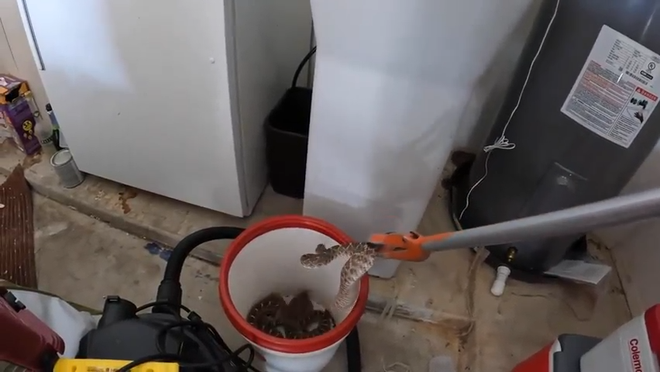Video shows 20 rattlesnakes being pulled out of Arizona man's garage: 'This is crazy'
A man in Arizona suspected that three rattlesnakes were hiding in his garage, but the reality was far worse. A snake catcher arrived at the man's home in Mesa and discovered there were actually 20 rattlesnakes in the garage.
On Tuesday, Marissa Maki, a snake wrangler, found most of the rattlers coiled around the hot water heater in a cluttered garage. She picked them up in clumps with her tongs.
"That is a lot of snakes," Maki said. "I'm not going to lie, this is crazy. I'm guessing more than one of these (adults) was a mom that had babies."
According to Maki, there were five adult western diamondback rattlesnakes, 15 babies, and one of the adults was pregnant. She also found a gap in the garage door's lower part, allowing snakes to come and go freely.
Company owner Bryan Hughes discovered multiple snake skin sheds in the garage, indicating the presence of up to 40 snakes at some point.
"This is our record for the most rattlesnakes caught in one call," said Hughes. "We'll never know how many rattlesnakes have come and gone over time."
A first:3-inch worm pulled from Australian woman's brain, researchers say

The property owner suspected that adults had entered the yard through a nearby desert wash, or a dry bed formed by an intermittent stream. During storms, washes can hold flood waters and serve as wildlife highways in dry periods.
"I tried waiting them out," the property owner said. "I only saw them from peeking around the corner. I thought there was an adult."
'Well I'll be':Michigan woman shocked to find gator outside home with mouth bound shut
More on western diamondback snakes
The western diamondbacks, known for their distinctive triangular heads, are found throughout the Southwest. Although their venom is less potent than other rattlesnake species, they still require careful handling.
The Desert Museum states that this snake is a generalist, which means it can adapt to various habitats. It can be found in deserts, grassy plains, forests, rocky hillsides, and coastal areas. It can also survive at different elevations, ranging from below sea level to 6,500 feet.
During the hot daytime, diamondbacks prefer to stay in the shade of low-growing shrubs, piles of natural or artificial debris, or rocks. They may also use underground burrows of other animals for protection. In winter, they hibernate in caves or similar places.
Disclaimer: The copyright of this article belongs to the original author. Reposting this article is solely for the purpose of information dissemination and does not constitute any investment advice. If there is any infringement, please contact us immediately. We will make corrections or deletions as necessary. Thank you.






